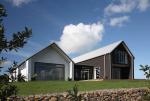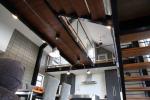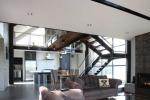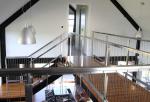Brae Barn, Glenbrook
When Alison and Alan bought their 1ha Glenbrook property, they envisaged building a home in sympathy with the area’s rural character.
“We didn’t want a starkly modern house because it just wouldn’t fit in,” says Alison.
“Some of the neighbouring properties are made of corrugate or clad in black, so we wanted to fit in with them. We also took inspiration from the rusting old iron-clad, barn-like structures around Glenbrook, whose forms stand out against the landscape.”
Alison says they initially planned to build three pavilions on the hilltop site because they liked the idea of their property looking as if it were a grouping of rural buildings and they also wanted separate quarters for their frequent visitors from the UK.
They had seen and liked the work of Pukekohe-based architect Jann Hurley so they brought her on board to realise their vision. They enjoyed her collaborative approach to design, and appreciated her ongoing support throughout the construction process, and afterwards.
“We had the idea of three shed-like pavilions but we didn’t quite have the room on the site because we are on a hill with a flat bit on the top but then it slopes off quite steeply,” says Alison.
Jann adds, “The three single-storey pavilions wouldn’t have worked without putting in massive retaining walls or digging down into the site.”
Neither of those options appealed aesthetically or economically so Jann came up with the idea of having one wing of the house one and half storeys and the other single-storey. The design involves two gable-roofed barn-like structures that sit side-by-side and are connected by a foyer beneath a lower pitched roof creating an H-shaped house. The roof at the middle of the H-shape extends to create a covered entrance between the ‘barns’ on the eastern side and a partially covered deck on the western side that then wraps around the rear of the home in front of the living area.
Alison says, “It was a eureka moment when we decided to go up another floor because it all started to come together then.
“We wanted the master bedroom to be separate from the other (guest) bedrooms, and in the end the best way to achieve this was to go up a level.
“This in turn allowed for the height and the open barn-like feeling to start to develop with the over-sized steel supports, the bridge, the huge window, all coming about due to the rise in building height. It also gives us amazing views from the master bedroom.”
Alison says they were also adamant about building the home oriented to the west so they could make the most of the views, despite facing into the prevailing winds.
“It is such a beautiful site with amazing views across the countryside and down to Awhitu Peninsula,” she says. “When we were planning the home all our friends were saying, ‘Of course you will be building to the north’, and we kept saying, ‘No, we are building to the west’.”
The two-level wing of the home features contrasting materials in stack-bonded blockwork and black-stained cedar, and houses the laundry, scullery, kitchen, dining room and living area on the ground floor. Exposed stairs rise past a double-height window to a bridge that spans a void between the master suite at the western end of the house and the mezzanine study at the eastern end.
The single-storey wing has a garage at the eastern end and beyond that a bathroom and two bedrooms, one of which has sliding doors opening to a patio with views to the west.
Instead of cedar and concrete block, this wing of the house has been clad in Zincalume® Corrugate, which has also been used to roof the whole home.
Alison says, “Initially, we did this to save money, but we really loved the contrast the corrugate provided with the other half of the house. It also fitted the agricultural-industrial look, instantly making it look more like a barn. The barn idea then came to influence a lot of other choices, such as the internal sliding barn door, the industrial look lighting, the flooring, the landscaping, even the name in the end.”
Jann Hurley says cedar facing has been used on the Zincalume® cladding to soften it a bit.
Inside, the home has what Alison describes as a “slightly agricultural/industrial look to it – sort of raw.”
Jann says, ”Stack-bonded block and exposed steel were two of the main things that they wanted right from the start, and the steel portal frame has great lines.”
And this was part of Jann’s brief: to use “common, hard-wearing rural materials with design flair to create a unique home”.
Jann says her colleague Damian Bell also had vital input on the project. “His attention to detail was critical in bringing to fruition the clean lines of intersection between the various materials.”
Stainless steel and railway tiles feature in the kitchen, which shares a polished concrete floor with the dining area that gives way to bamboo flooring in the lounge. Bamboo is also used in the exposed treads of the steel staircase and the flooring on the steel bridge. The steelwork, including the portal frame, is painted black to emphasise its strong lines.
Another substantial feature that was a must have for Alan is the sliding barn door that can be used to shut the guest wing off from the main part of the house.
The sliding barn door, like the front door, the garage door and the cladding, is made of cedar and stained in Resene Sheer Black so that the grain of the wood is still visible.
A stainless steel post and wire balustrade on the stairs, bridge and mezzanine floor enhances the industrial look and, as Alison points out, “it allows the light from the window to filter through the staircase”.
The industrial feel has been further emphasised by Alison stenciling “Brae Barn” in black on the Zincalume® cladding.
Alison explains that the name came around because Alan is Scottish and in his homeland a brae is a hill.
The Scottish theme extends to include West Highland terrier dogs and Galloway cattle on their property.
Having used Zincalume® for cladding and loving the look, the couple are now using it in fencing as they continue landscaping the property. The use of steel gabion baskets filled with local Mangatangi River rock helps completes the industrial/agricultural feel of the property.





